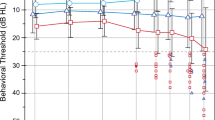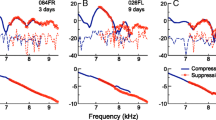Abstract
Otoacoustic emissions (OAEs) arise from one (or a combination) of two basic generation mechanisms in the cochlea: nonlinear distortion and linear reflection. As a result of having distinct generation processes, these two classes of emissions may provide non-redundant information about hair-cell integrity and show distinct sensitivities to cochlear pathology. Here, we characterize the relationship between reflection and distortion emissions in normal hearers across a broad frequency and stimulus-level space using novel analysis techniques. Furthermore, we illustrate the promise of this approach in a small group of individuals with mild-moderate hearing loss. A “joint-OAE profile” was created by measuring interleaved swept-tone stimulus-frequency OAEs (SFOAEs) and 2f1-f2 distortion-product OAEs (DPOAEs) in the same ears using well-considered parameters. OAE spectra and input/output functions were calculated across five octaves. Using our specific recording protocol and analysis scheme, SFOAEs in normal hearers had higher levels than did DPOAEs, with the most pronounced differences occurring at the highest stimulus levels. Also, SFOAE compression occurred at higher stimulus levels (than did DPOAE compression) and its growth in the compressed region was steeper. The diagnostic implications of these findings and the influence of the measurement protocol on both OAEs (and on their relationship) are discussed.












Similar content being viewed by others
References
Abdala C, Luo P, Shera CA (2015) Optimizing swept-tone protocols for recording distortion-product otoacoustic emissions in adults and newborns. J Acoust Soc Am 138:3785–3799
Abdala C, Kalluri R (2017) Towards a joint reflection-distortion otoacoustic emission profile: Results in normal and impaired ears. J Acoust Soc Am 142:812–824
Abdala C, Guardia YC, Shera CA (2018a) Swept-tone stimulus-frequency otoacoustic emissions: Normative data and methodological considerations. J Acoust Soc Am 143:181–192
Abdala C, Ortmann AJ, Shera CA (2018b) Reflection- and distortion-source otoacoustic emissions: Evidence for increased irregularity in the human cochlea during aging. J Assoc Res Otolaryngol 19:493–510
Abdala C, Ortmann AJ, Guardia YC (2021) Weakened Cochlear nonlinearity during human aging and perceptual correlates. Ear Hear 42:832–845
Bergevin C, Fulcher A, Richmond S, Velenovsky D, Lee J (2012) Interrelationships between spontaneous and low-level stimulus-frequency otoacoustic emissions in humans. Hear Res 285:20–28
Bitner-Glindzicz M (2002) Hereditary deafness and phenotyping in humans. Br Med Bull 63:73–94
Charaziak KK, Shera CA (2017) Compensating for ear-canal acoustics when measuring otoacoustic emissions. J Acoust Soc Am 141:515–531
Cheatham MA, Ahmad A, Zhou Y, Goodyear RJ, Dallos P, Richardson GP (2016) Increased spontaneous otoacoustic emissions in mice with a detached tectorial membrane. J Assoc Res Otolaryngol 17:81–88
Cheatham MA, Goodyear RJ, Homma K, Legan PK, Korchagina J, Naskar S, Siegel JH, Dallos P, Zheng J, Richardson GP (2014) Loss of the tectorial membrane protein CEACAM16 enhances spontaneous, stimulus-frequency, and transiently evoked otoacoustic emissions. J Neurosci 34:10325–10338
Christensen AT, Abdala C, Shera CA (2020) A cochlea in three parts? Evidence from otoacoustic emission phase in humans. J Acoust Soc Am 148:1585–1601
Dewey JS, Dhar S (2017) Profiles of stimulus frequency otoacoustic emissions from 0.5 to 20 kHz in humans. J Assoc Res Otolaryngol 18:89–110
Dorn PA, Konrad-Martin D, Neely ST, Keefe DH, Cyr E, Gorga MP (2001) Distortion product otoacoustic emission input/output functions in normal-hearing and hearing-impaired human ears. J Acoust Soc Am 110:3119–3131
Ellison JC, Keefe DH (2005) Audiometric predictions using SFOAE and middle-ear measurements. Ear Hear 26:487–503
Gorga MP, Neely ST, Bergman B, Beauchaine KL, Kaminski JR, Peters J, Jesteadt W (1993) Otoacoustic emissions from normal-hearing and hearing-impaired subjects: distortion product responses. J Acoust Soc Am 93:2050–2060
Gorga MP, Neely ST, Ohlrich B, Hoover B, Redner J, Peters J (1997) From laboratory to clinic: a large-scale study of distortion product otoacoustic emissions in ears with normal hearing and ears with hearing loss. Ear Hear 18:440–455
Hudspeth AJ, Corey DP (1977) Sensitivity, polarity, and conductance in the response of vertebrate hair cells to controlled mechanical stimuli. Proc Natl Acad Sci USA 74:2407–2411
Kalluri R, Shera CA (2007) Comparing stimulus-frequency otoacoustic emissions measured by compression, suppression, and spectral smoothing. J Acoust Soc Am 122:3562–3575
Kalluri R, Shera CA (2013) Measuring stimulus-frequency otoacoustic emissions using swept tones. J Acoust Soc Am 134:356–368
Keefe DH, Feeney PM, Hunter LL, Fitzpatrick DF, Blankenship CM, Garinis AC, Putterman DB, Wroblewski M (2019) High frequency transient-evoked otoacoustic emission measurements using chirp and click stimuli. J Acoust Soc Am 371:117–139
Keefe DH, Goodman SS, Ellison JC, Fitzpatrick DF, Gorga MP (2011) Detecting high-frequency hearing loss with click-evoked otoacoustic emissions. J Acoust Soc Am 129:245–261
Kemp DT (1997) Otoacoustic emissions in perspective. In: Robinette MS, Glattke TJ (eds) Otoacoustic Emissions: Clinical Applications. Thieme, New York, pp 1–21
Kemp DT, Brown AM (1983) A comparison of mechanical nonlinearities in the cochleae of man and gerbil from ear canal measurements. In: Klinke R, Hartmann R (eds) Hearing-Physiological Bases and Psychophysics. Springer-Verlag, Berlin, pp 75–82
Knight RD, Kemp DT (1999) Relationships between DPOAE and TEOAE characteristics. J Acoust Soc Am 106:1420–1435
Knight RD, Kemp DT (2000) Indications of different distortion product otoacoustic emission mechanisms from a detailed f1, f2 area study. J Acoust Soc Am 107:457–473
Knight RD, Kemp DT (2001) Wave and place fixed DPOAE maps of the human ear. J Acoust Soc Am 109:1513–1525
Kummer P, Janssen T, Arnold W (1998) The level and growth behavior of the 2f1 - f2 distortion product otoacoustic emission and its relationship to auditory sensitivity in normal hearing and cochlear hearing loss. J Acoust Soc Am 103:3431–3444
Lee C, Valenzuela CV, Goodman SS, Kallogjeri D, Buchman CA, Lichtenhan JT (2020) Early detection of endolymphatic hydrops using the auditory nerve overlapped waveform (ANOW). Neuroscience 425:251–266
Long GR, Talmadge CL, Lee J (2008) Measuring distortion product otoacoustic emissions using continuously sweeping primaries. J Acoust Soc Am 124:1613–1626
Maxim T, Shera CA, Charaziak KK, Abdala C (2019) Effects of forward-and emitted-pressure calibrations on the variability of otoacoustic emission measurements across repeated probe fits. Ear Hear 40:1345–1358
Mills ML, Shen Y, Withnell RH (2021) Examining the factors that contribute to non-monotonic growth of the 2f1 - f2 otoacoustic emission in humans. J Assoc Res Otolaryngol 22:275–288
Moleti A, Longo F, Sisto R (2012) Time-frequency domain filtering of evoked otoacoustic emissions. J Acoust Soc Am 132:2455–2467
Neely ST, Gorga MP, Dorn PA (2003) Cochlear compression estimates from measurements of distortion-product otoacoustic emissions. J Acoust Soc Am 114:1499–1507
Neely ST, Johnson TA, Gorga MP (2005) Distortion-product otoacoustic emission measured with continuously varying stimulus level. J Acoust Soc Am 117:1248–1259
Neely ST, Johnson TA, Kopun JG, Dierking DM, Gorga MP (2009) Distortion-product otoacoustic emission input/output characteristics in normal-hearing and hearing-impaired human ears. J Acoust Soc Am 126:728–738
Ortmann AJ, Abdala C (2016) Changes in the compressive nonlinearity of the cochlea during early aging: Estimates from distortion OAE Input/Output functions. Ear Hear 37:603–614
Rydmarker S, Horner KC (1990) Morphological changes of hair cell stereocilia and tectorial membrane in guinea pigs with experimentally induced hydrops. Scanning Microsc 4:18
Rydmarker S, Horner KC (1991) Atrophy of outer hair cell stereocilia and hearing loss in hydropic cochleae. Hear Res 53:113–122
Schairer KS, Ellison JC, Fitzpatrick D, Keefe DH (2006) Use of stimulus-frequency otoacoustic emission latency and level to investigate cochlear mechanics in human ears. J Acoust Soc Am 120:901–914
Schairer KS, Fitzpatrick D, Keefe DH (2003) Input-output functions for stimulus-frequency otoacoustic emissions in normal-hearing adult ears. J Acoust Soc Am 114:944–966
Schairer KS, Keefe DH (2005) Simultaneous recording of stimulus-frequency and distortion-product otoacoustic emission input-output functions in human ears. J Acoust Soc Am 117:818–832
Scheperle RA, Goodman SS, Neely ST (2011) Further assessment of forward pressure level for in situ calibration. J Acoust Soc Am 130:3882–3892
Scheperle RA, Neely ST, Kopun JG, Gorga MP (2008) Influence of in situ, sound-level calibration on distortion-product otoacoustic emission variability. J Acoust Soc Am 124:288–300
Shera CA, Abdala C (2016) Frequency shifts in distortion-product otoacoustic emissions evoked by swept tones. J Acoust Soc Am 140:936–944
Shera CA, Bergevin C (2012) Obtaining reliable phase-gradient delays from otoacoustic emission data. J Acoust Soc Am 132:927–943
Shera CA, Guinan JJ (1999) Evoked otoacoustic emissions arise by two fundamentally different mechanisms: A taxonomy for mammalian OAEs. J Acoust Soc Am 105:782–798
Shera CA, Guinan JJ, Oxenham AJ (2002) Revised estimates of human cochlear tuning from otoacoustic and behavioral measurements. Proc Natl Acad Sci USA 99:3318–3323
Shera CA, Zweig G (1993) Order from chaos: resolving the paradox of periodicity in evoked otoacoustic emission. In: Duifhuis H, Horst JW, van Dijk P, van Netten SM (eds) Biophysics of hair cell sensory systems. World Scientific, Singapore, pp 54–63
Souza NN, Dhar S, Neely ST, Siegel JH (2014) Comparison of nine methods to estimate ear-canal stimulus levels. J Acoust Soc Am 136:1768–1787
Stiepan S, Shera CA, Abdala C (2022) Characterizing the joint-OAE profile in individuals with endolymphatic hydrops. Assoc Res Otolaryngol Abs 45
Talmadge CL, Tubis A, Long GR, Piskorski P (1998) Modeling otoacoustic emission and hearing threshold fine structures. J Acoust Soc Am 104:1517–1543
Talmadge CL, Long GR (2010) Continuously swept tone paradigm for DPOAE measurements. Assoc Res Otolaryngol Abs 33:50
Verpy E, Leibovici M, Michalski N, Goodyear RJ, Houdon C, Weil D, Richardson GP, Petit C (2011) Stereocilin connects outer hair cell stereocilia to one another and to the tectorial membrane. J Comp Neurol 519:194–210
Verpy E, Masmoudi S, Zwaenepoel I, Leibovici M, Hutchin TP, Del Castillo I, Nouaille S, Blanchard S, Lainé S, Popot JL, Moreno F (2001) Mutations in a new gene encoding a protein of the hair bundle cause non-syndromic deafness at the DFNB16 locus. Nat Genet 29:345–349
Verpy E, Weil D, Leibovici M, Goodyear RJ, Hamard G, Houdon C, LefËvre GM, Hardelin JP, Richardson GP, Avan P, Petit C (2008) Stereocilin-deficient mice reveal the origin of cochlear waveform distortions. Nature 456:255–258
Whitehead ML, Stagner BB, Martin GK, Lonsbury-Martin BL (1996) Visualization of the onset of distortion-product otoacoustic emissions, and measurement of their latency. J Acoust Soc Am 100:1663–1679
Yates GK, Winter IM, Robertson D (1990) Basilar membrane nonlinearity determines auditory nerve rate-intensity functions and cochlear dynamic range. Hear Res 45:203–219
Zelle D, Thiericke JP, Dalhoff E, Gummer AW (2015) Level dependence of the nonlinear-distortion component of distortion-product otoacoustic emissions in humans. J Acoust Soc Am 138:3475–3490
Zweig G, Shera CA (1995) The origin of periodicity in the spectrum of evoked otoacoustic emissions. J Acoust Soc Am 98:2018–2047
Acknowledgements
The authors thank Chandan Suresh and Monica Padilla for assistance with scheduling/testing in the early phases of this study and Samantha Stiepan for providing comments on an earlier version of this manuscript.
Funding
This study is supported by grants DC003552 (CA) and DC018307 (CA, CAS) from the National Institutes of Health.
Author information
Authors and Affiliations
Corresponding author
Ethics declarations
Conflict of Interest
The authors declare no competing interests.
Additional information
Publisher's Note
Springer Nature remains neutral with regard to jurisdictional claims in published maps and institutional affiliations.
Rights and permissions
About this article
Cite this article
Abdala, C., Luo, P. & Shera, C.A. Characterizing the Relationship Between Reflection and Distortion Otoacoustic Emissions in Normal-Hearing Adults. JARO 23, 647–664 (2022). https://doi.org/10.1007/s10162-022-00857-z
Received:
Accepted:
Published:
Issue Date:
DOI: https://doi.org/10.1007/s10162-022-00857-z




